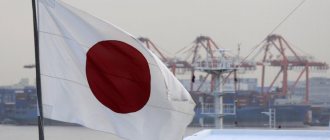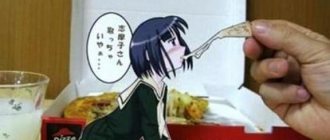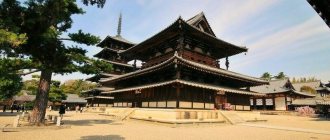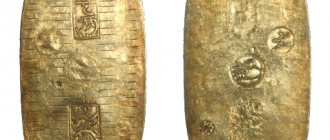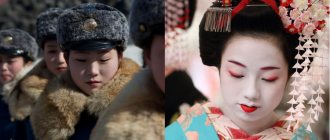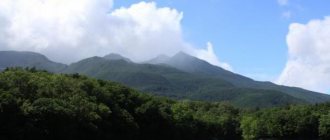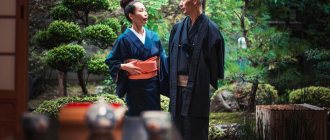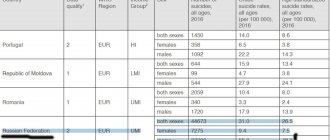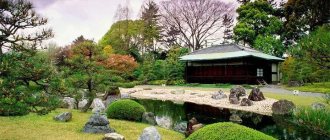Geographical location of Japan
Japan is located along the eastern coast of Asia on an arched archipelago and has a length of about 3,800 kilometers from north to south. The archipelago includes about 4 thousand islands, the largest of which are Hokkaido, Honshu, Shikoku and Kyushu. They account for 98% of Japan's land area, and the country's total area is 380,000 square meters. km. Large islands are connected to each other by a system of bridges and tunnels. The country's territory is gradually increasing due to the creation of artificial islands.
Japan is a country located on a stratovolcanic archipelago in the Pacific Ocean.
Japan is surrounded on all sides by water - the Sea of Okhotsk, the Sea of Japan, the East China Sea and the Pacific Ocean. With its closest neighbors - China, Russia, South and North Korea - the country has only maritime borders.
Characteristics of the Japanese model
The main feature is the principle of lifelong employment. To advance up the career ladder, the main advantage is the years devoted to the company. If a person moves to another company, his length of service is reset and he will have to start his career all over again. Moreover, such an employee is considered an unreliable second-class person; he will always be different from native employees. According to management experts, the Japanese type of management has the following characteristics:
- Guaranteed employment, a trusting, family environment in the team. People have been working at the same company with the same people for decades. Such stability and cohesion contributes to the complete absence of staff turnover and strengthens corporate ties. Employees are not afraid of being fired and have good prospects for vertical advancement due to their many years of experience. And this is a good motivation to improve the quality of work for the benefit of the prosperity of your organization.
- Glasnost and creation of a common system of corporate values. Everything that happens in the organization is immediately known to all employees, down to the rank and file. Senior management regularly meets with heads in the administration. They, in turn, convey information to department heads, trying to maintain a single corporate spirit. The system of moral values that has developed in the company is the same for all management levels and for all employees.
- The main principle of management is information. At any large enterprise, much attention is paid to data collection, systematization and subsequent use.
- Japanese management is quality oriented. Strengthening control over all stages of work, obtaining accurate data on the quality of products can become the personal pride of the department head, an example for others and will help advance your career ahead of schedule.
- Management regularly monitors the production process. At most enterprises, the management administration is located directly in the production shops. All problems are resolved immediately, and improvements are implemented just as quickly.
- Exceptional cleanliness and order are a sign of harmony.
The specifics of eastern management are based on the moral qualities of all personnel , stability of employment, exceptional consistency both vertically and horizontally (between departments).
Japan is the only country in the world where lifelong employment exists. The exception is Korean management, but it is completely borrowed from the Land of the Rising Sun.
Relief, climate
The Japanese archipelago is part of the Pacific Volcanic Ring (an area along the borders of the Pacific Ocean with great seismological activity). The main relief is mountains, most of them are volcanic peaks. There are about 200 volcanoes on the islands, of which 67 are considered active. The highest (3776 meters) and famous mountain in Japan is Fuji. It is also a dormant volcano. Earthquakes often occur on the islands, which are accompanied by giant waves - tsunamis.
Mount Fuji on the island of Honshu. Photo: flickr.com/FreeImages
The fairly large extent of the archipelago determines its varied climate - temperate in the north and subtropical in the south. Monsoon winds have a great They change their direction depending on the time of year. In winter they blow from the mainland, in summer - in the opposite direction.
Abstract: History of Japan
Origins.
Archaeological research has established that ca. 7000 BC The most ancient Neolithic tribes lived on the territory of Japan (the so-called protojomon culture). It is obvious that at a later time the peoples of Northeast Asia had a significant influence on the formation of the physical type and the formation of the culture of the local population. It is also appropriate to talk about the presence of influence coming from Southern China or Southeast Asia.
The earliest Japanese culture is called Jomon (VI-I millennium BC). It is characterized by finds of pottery with a “rope pattern”. The primitive tribes of this time were engaged in hunting, gathering, fishing and collecting edible shellfish in the coastal strip. They lived in dugouts and made clay products by hand, without using a potter's wheel. Around the 3rd century. BC. Jomon began to be replaced in western Japan by the Yayoi culture, which is characterized by pottery made on a potter's wheel. The tribes of the Yayoi culture were engaged in rice cultivation and raising livestock - cows, pigs, horses. Bronze tools and weapons were borrowed from China and Korea. In the 1st century AD Bronze was widely used to produce ceremonial items such as mirrors and bells.
The Jomon culture dominated northern and eastern Japan for many centuries. In the central and western regions of the country, starting from the mid-3rd century. AD The Yayoi culture was supplemented by the Kurgan culture, named for the presence of huge mounds in which rulers and nobility were buried. Based on pottery (haniwa) and other finds in and near the burials, one can draw conclusions about the lifestyle of the people of that era. The ruling class consisted of horse-riding warriors who used iron weapons. This culture probably had similarities with contemporary Korean culture.
It can definitely be said that the founders of the Japanese state were buried under the mounds, although early chronicles based on oral tradition indicate that the imperial dynasty is much older and originates from ordinary mortals who lived on the island. Kyushu, and the descendants of the sun goddess Amaterasu. Undoubtedly, the first emperors adhered to this version. The country did not have a permanent capital, and each emperor moved it at his own discretion. By the end of the 3rd century. the center of power was located on the Yamato Plain, on the site of the modern city of Nara. From here he moved to Izumo, near the coast of the Sea of Japan, then to Kyushu, and even later to the east, to the Kanto Plain, in the area of modern Tokyo. Here the position of the emperors was weaker, the land and people remained under the control of semi-autonomous clans called uji (which included the imperial clan). Nevertheless, the existing system of political organization allowed the emperors in the second half of the 4th century. expand to the south of Korea. Emperors Ojin (c. 346–395) and Nintoku (c. 395–427) had great power and enormous wealth, as evidenced by the size of the mounds under which they are buried.
Chinese influence.
The military intervention in Korea led to the expansion of contacts with a highly developed civilization on the continent - directly with the Korean, and indirectly with the Chinese. One of the results was the introduction of Japan to many knowledge and crafts. A particularly important acquisition was writing, introduced around the beginning of the 5th century. Since then, chronicles began to be compiled, mainly in Chinese, although techniques for using Chinese writing for the needs of the Japanese spoken language were gradually developed. By the beginning of the 7th century. the search for knowledge was carried out directly in China, where an official mission was sent in 607, and a year later a group of students.
One of the motivations for maintaining ties with China was the introduction to Buddhism. This religion began to spread in 552, when one of the Korean kingdoms sent priests, sutras and an image of Buddha to Japan. However, due to opposition from families associated with traditional Japanese beliefs, which later became known as Shinto (the way of the gods), as opposed to Butsudo (the way of the Buddha), Buddhism became firmly established here only at the very end of the 6th century. The new religion brought happiness to the Soga family, who, after winning a conflict over the succession to the throne in 587–588, installed their pretender on the throne. From then on, Buddhism was accepted by the palace elite, and in most cases its adherents were the emperor himself and the high nobility. Shintoism retained the significance of a ceremonial religion.
During the reign of the Soga dynasty, particularly during the reign of Empress Suiko (593–628), the process of familiarization with Chinese culture extended to political institutions. Empress Shotoku's nephew, as crown prince, formally headed the administration, and Constitution 604, which established a code of conduct for court officials, was named after him. It regulated issues of ethics and management and used terms borrowed from Buddhist and Confucian texts. For the nobility, a system of ranks was established on the Chinese model, and court ceremonies were revised.
The Soga family tried to strengthen the monarch's power over the major clans. Not surprisingly, this caused opposition from other families. In 645, the head of one of them, Nakatomi no Kamatari, with the help of members of the imperial house, organized a coup, as a result of which his protege was on the throne, and his allies occupied all key posts. The Chinese calendar and mottos denoting reign eras (nengo) were adopted.
Taika Reform and the Taiho Code.
The main meaning of the Taika reforms (the first era of nengo) was, according to the decrees of 645–646, to assert the rights of the emperor to the lands and people of Japan. All land was declared the property of the state. Part of it was to be allocated to the nobility in accordance with social and official status, but the majority was intended for those who processed it, taking into account the size of peasant families. In turn, the peasants had to pay taxes, mainly in rice and textiles, as well as by performing certain tasks. To control the state of local affairs, imperial officials were appointed heads of provinces and districts, so that centralized authority everywhere replaced the jurisdiction of private individuals.
Available evidence suggests that reforms were never fully implemented, perhaps with the exception of areas surrounding the capital. Many officials in the districts were recruited from among influential local families interested in poor execution of decrees. The influence of the nobility, even at court, was not completely destroyed. Later, in the same 7th century, the process of concentration of power was resumed and bore fruit in the form of a legislative and administrative code published in 701–702, already in the Taiho era.
The Taiho Code, in addition to approving and consolidating the changes that occurred during the Taika period, led to the creation of a centralized management system in the country. This system was borrowed from China, where the Tang dynasty then ruled, but had a number of differences due to specific searches, problems and ideas. Administrative control fell into the hands of councils and groups, whose members were drawn from among the courtiers according to their hereditary titles. The highest provincial officials, whose main concern was the collection of taxes, were appointed from the same strata. However, lower-ranking officials were local residents, and the villages themselves were given autonomy. The Taihō system established a tradition of centralized imperial rule that was never substantially changed, although for long periods of Japanese history it was given more tribute to it in words than in deeds.
Nara and Heian.
In 710 a permanent capital was founded at Nara.
Previously, the capital was located where the palace was located, and changed location with the arrival of the new emperor. However, Nara, modeled after the Chinese capital Chang'an, remained the capital until 784. Many sanctuaries and temples were built in and around it. In 712, scholars completed a chronicle detailing the history of the country since mythical times ( Kojiki
, written in a variant of the Japanese language).
In 720, the chronicle Nihongi
, or
Nihon-shoki
, appeared, written in Chinese and the first in a series of similar works that continued the narrative until 887. Equally famous is
Manyoshu
, the first Japanese anthology compiled in poetic form in the second half of the 8th century.
The new capital of Heian gained great fame as a cultural center. The decision to move the capital was made in 784, probably under the influence of Buddhists. However, only 10 years after the appearance of the corresponding intentions, a place was chosen and, finally, a city was built, also built on the model of Chang'an. This was Heian (Heiankyo), later renamed Kyoto, and remained the imperial residence until 1869.
The organization of religious life in sects, also carried out according to the Chinese model, began in Nara. Two sects that arose at the beginning of the 9th century soon became leading. The first of them was Tendai, created by the monk Saicho who returned from China in 805. Numerous inhabitants of the Enryakuji monastery he founded on Mount Hiei, northeast of Heian, eventually began to play a prominent role in political life. Another religious sect, Shingon, was organized by Kobo Daishi, who chose Mount Koya, located south of the Nara Valley, as his residence in 816.
In the 8th–9th centuries. monasteries also appeared in the provinces. However, most of the achievements of Japanese civilization at that time were concentrated in two capitals, Nara and Heian. It was in these centers that painting and sculpture developed, largely under the influence of Buddhism, and the writing of poetry, calligraphy, and the performance of music and dance became symbols of a refined aristocratic society. This society numbered only a few thousand members, keen mainly on ceremonial, keenly aware of the prestige of their titles and convinced that leaving the capital meant exile in a cultural desert. Making great efforts to ensure that the surrounding reality satisfied their aesthetic tastes, they reflected it in fascinating biographies, the most outstanding of which is Genji Monogatari
(
The Tale of Genji
) by court writer Murasaki Shikibu.
Fujiwara.
By the end of the 9th century.
members of the Fujiwara family dominated Heian both politically and socially. Heirs of the 7th century statesman. Nakatomi no Kamatari, from the first days of the clan's existence, they used every opportunity to marry their daughters to representatives of the imperial dynasty, so that in the Heian era (794–1185) most emperors were their relatives on the maternal side. Taking advantage of the situation, the Fujiwaras soon established control over all important government agencies. In 858 Fujiwara Yoshifusa became the first regent. In 880, Mototsune, Yoshifusa's nephew, assumed the title of kampaku, which gave him the rights of regent under the adult emperor. The power of the Fujiwara clan reached its peak during the time of Fujiwara Michinaga (reigned 996 to 1017). The ruler's wealth and prestige are captured in the title of the most famous chronicle of the period, Eiga-monogatari
(
Tale of Splendor
).
Fujiwara's power depended not only on connections with the imperial court. The family created enormous wealth through the acquisition of land holdings in the province, but did not have an army. In addition, family members remained people of the capital and court. Emperor Go-Sanjo (1068–1072) was the first of the rulers to seriously attempt to consolidate his own power by abdicating in favor of his son, and to take advantage of paternal privileges as opposed to similar rights that the Fujiwara secured for themselves through the establishment of kinship relations with the emperors. Thus, a precedent arose, which is the so-called. retired emperors could use it in the future. Along with the observed increase in the power of armed feudal lords in the province, this contributed to the decline of Fujiwara's power.
Further development.
After passing the middle of the Heian era, Japan began to move away from the Chinese model.
In language, the invention of the kana phonetic syllabary opened the way to more popular forms of prose written in Japanese (example: The Tale of Genji
), and although Chinese remained the language of official documents, after the 12th century. even historical chronicles were sometimes written in Japanese. Original national forms emerged in art and architecture; This is especially true for painting in the yamato-e genre, the most famous examples of which are scroll paintings.
Changes also occurred in Buddhism. The use of a simple kana script and a greater emphasis on prayer (nembutsu) than on scripture and ritual allowed the clergy to significantly expand their audience. The Pure Land (Jodo) sect, founded by Honen (1133–1212), and the True Pure Land (Shinshu) sect, founded by his disciple Shinran (1173–1262), quickly gained large numbers of followers. Another new sect, named after its founder Nichiren (1222–1282), although less popular, was militantly Japanese in character. By the end of the Heian era, there was already Rebu (double) Shinto, in which Shinto deities were seen as local manifestations of the Buddha. Shinto temples increasingly came under the control of Buddhist monks.
The most dramatic changes occurred in the political sphere. Already the Fujiwara family had moved somewhat away from Chinese models, using their personal authority and the institutions dependent on it to circumvent the system of groups and councils that existed under Taiho. With the fall of Fujiwara, this process continued, contributing to the formation of a system close to Western European feudalism.
The growing wealth of the Buddhist communities, in parallel with the constant increase in the cultivated wedge, led to the fact that by the 12th century. arable land was mainly included in huge private lands free from taxation, called shoen; local families often included their own plots among them.
This development weakened not so much Fujiwara as the state financial system, since nobles and Buddhist communities tended to be patronized by the shōen, receiving income from them in exchange for ensuring their interests. The changes were accompanied by a decline in law and order, which undermined Fujiwara's power. The local nobility resorted to hiring bodyguards, detachments of which by the 10th century. turned into real private armies. Most of these warriors were associated with shōen; thus a warrior class began to form.
Taira and Minamoto.
The new organization of society took shape in the process of developing a system of vassal relations. A number of prominent military houses became its core. The largest of these were Taira and Minamoto, both including descendants of the imperial family and founded by people who left the capital to try to gain power in the provinces. The Taira initially settled in the Kanto region in the east, where in 935 one of them moved against the center. The campaign launched against him was marked by the rise of the Minamoto family, which acquired a large number of supporters both in Kanto and in the areas adjacent to the capital. The Taira responded by expanding their influence along the coast of the Inland Sea of Japan.
The Minamoto formed an alliance with the Fujiwara, suppressing a series of rebellions that broke out in the 11th century. on the periphery. However, in the 12th century. The Taira also successfully moved closer to the court, providing support to the abdicated emperors. In 1156–1159, Taira Kiyomori, having won a confrontation over the issue of succession to the throne, seized power and removed most of the Minamoto representatives from government institutions. In 1180, there was a rebellion in Kanto led by Minamoto Yorimoto. After five years of fighting, the Taira were finally defeated at the naval battle of Dannoura (1185).
Military government of Kamakura.
In 1192 Yorimoto received the title of shogun, i.e. Generalissimo, formally becoming the emperor's representative on military issues, and in fact the ruler of Japan. His headquarters in Kamakura (near modern Tokyo), known as the bakufu, has since become the administrative capital of the country. Heian continued to be home to the imperial court, with Fujiwara and other members of the nobility holding high positions, but the city ceased to serve as a center of political power. To control the implementation of his decisions, the shogun appointed his own vassals (gokenin) as military governors (shugo) in the provinces and managers (jito) in most large private estates. Although government officials loyal to the court continued to serve alongside the new military administrators, it was the latter who soon assumed a privileged position, using their powers not only to strengthen the power of the bakufu, but also to enrich themselves.
After Yorimoto's death in 1199, control of the country was taken over by his father-in-law, Hojo Tokimasa, whose family held power through a regency until the 14th century. When the Minamoto branch fell in 1219, the position of shogun passed to a representative of the Fujiwara family, appointed by the Hojo family, despite the attempt of the abdicated Emperor Go-Toba (reigned 1183–1198) to restore his power. Go-Toba succeeded only in giving Hojo the opportunity to demonstrate military superiority and confiscate even more land, and was eventually exiled in 1221. The jito system was expanded and used to reward gokenin; A period of tranquil rule began in Kamakura. Since 1252, the regents could attract even princes from the imperial family to the position of shogun.
The Hōjō administration was concerned primarily with controlling members of the military class, or samurai, and with settling conflicts over issues such as land rights, inheritance matters, or vassal status. The costs of administration were small, since most officials received their remuneration from the income received from the shōen to which they were assigned. Thus, the general taxation system turned out to be unnecessary: the necessary funds came to the shogun from his own estates. This made it possible to make the regime stable and popular.
—> READ COMPLETELY
Population and government
Due to its geographical location, Japan was isolated from the main world for a long time and was not influenced by other nations. This led to the development of a unique culture and unique mentality, as well as the preservation of a homogeneous national composition: 99% of the country's inhabitants are Japanese.
The total population is about 127 million people (for comparison, Russians are about 146 million people). High population density has contributed to urbanization - 80% of Japanese live in cities. There are 11 million-plus cities in Japan, including the country's capital, Tokyo. The average life expectancy of the Japanese is the highest in the world - 82 years.
Tokyo is the capital of the Land of the Rising Sun. Photo: flickr.com/BLucava
The government system is a constitutional monarchy. The Emperor is considered the formal head of state. The system of government is divided into three branches according to the European model:
- Legislative (bicameral parliament).
- Executive (cabinet of ministers, local administrative bodies). The Prime Minister is the de facto leader of the country.
- Judicial (supreme and regional courts).
Population of Japan
In terms of population (125,860 thousand people at the end of September 1999), Japan ranks 8th in the world after China, India, the USA, Indonesia, Brazil, Russia and Pakistan. Over 100 years, its population increased from 35.3 million people. in 1875 to 111.9 million people. in 1975
In recent years, the population has changed slightly. In 1998, compared to 1997, the increase was only 0.2%, which is one of the lowest rates since 1968, when regular demographic observations began in the country.
The population density of Japan is 331 people. per 1 sq. km.
Japan's population is extremely homogeneous, with less than 1% of non-Japanese people living in the country. Among the national minorities, the most numerous are Koreans - about 700 thousand people.
The vast majority of Japanese (78%) live in big cities today, and this trend continues to increase. However, the bulk of the urban population is still concentrated in three huge metropolitan areas - Tokyo, Nagoya and Osaka, which follow one another on a narrow flat strip along the Pacific coast.
The ratio of men to women in Japan's population is almost equal to one: in 1996, women accounted for 50.99% and men 49.01%.
Over the past decades, the nature of the natural population movement has changed dramatically. Japan became the first Asian state to move from the second to the first type of population reproduction. This “demographic revolution” happened in a very short time. It was a consequence of socio-economic transformations in Japanese society, achievements in the field of education and health care. Japan is the country with the lowest infant mortality rate in the world. State demographic policy also had a great influence. The ratio of men to women in the Japanese population is almost equal to one. In recent years, the process of “aging” of the population, as a result of declining birth rates and increasing life expectancy, has become an acute problem in Japan. This process occurs here much faster than in other developed capitalist countries.
National language and religion, cultural characteristics
Japanese does not belong to any language group and is considered one of the most difficult to learn.
The main national religion is Shintoism, from which the rather pronounced nationalism of the Japanese originates. According to religious teachings, the main deity Kami did not create all people, but exclusively the Japanese. Representatives of the imperial family are supposedly direct descendants of the supreme goddess. Therefore, a change in the ruling dynasty must not be allowed, otherwise the gods will turn away from the state.
Japanese women are beautiful and mysterious. Photo: flickr.com/BillGreen
Speaking about Japanese culture, one cannot ignore the following symbols, known throughout the world.
- the national costume , kimono, along with European clothing. There are different types of kimonos for indoors and outdoors. Most often it is worn on holidays and special occasions.
- Karate in Japan is not just a type of fighting, but a whole system of philosophy and values. This is an art that strengthens the body and spirit. Its study lasts a lifetime.
- Tanka and haiku (haiku) are the oldest poetic genres of the Japanese. The first - short songs of five lines - were usually dedicated to nature and its phenomena, for example, the seasons. Three-verse haiku is a later genre. Their authors are called haijin, and the most famous of these poets is Matsuo Basho. Back in the 17th century, he filled these short poems with philosophical content.
- very important for the Japanese. This is a whole ritual of cleansing and relaxation, which follows strict rules.
- Sushi is a traditional Japanese dish of rice with seafood and vinegar seasoning. Since the 80s, this dish has become popular all over the world.
- Japanese anime animation is noticeably different from Western animation. This genre is characterized by the seriousness of the plots. By the appearance of the hero one can draw a conclusion about his character. For example, kind and cheerful characters have large and shiny eyes, while evil and withdrawn characters have narrow or half-closed ones. The mood and emotions of each character are also carefully thought out and expressed in graphic ways. Anime is produced not only for children, but also for teenagers and adults.
- Sumo wrestling is one of the oldest symbols of Japan. At the same time, it is a martial art, a sport, and a spectacular pop performance.
4. Sights of Japan
Japan is undoubtedly a unique, incomparable and completely mysterious country, the like of which is almost impossible to find in the world. And it's not just about its rich and ancient heritage - Japan itself is a huge museum.
There is a common phrase: “Japan is a land of contrasts,” and these are not just words. Here temples coexist with modern life; they do not disturb the general flow, but form a single whole.
Nature and Japan are two inseparable concepts. For example, Nara is called the city of deer. More than a thousand noble spotted animals roam freely in the huge Nara Park and often wander into city streets. Everywhere, salted cookies are sold especially for feeding them, which they take directly from their hands. The history of their appearance is connected with the founding of the Shinto shrine Kasuga, one of the buildings of which is dedicated to a deity brought from the mountains by a deer.
There is a garden in Kyoto at the Rodzan Temple that combines fidelity to old traditions with new creative thinking. This garden is only 33 years old, it was created in memory of the famous 11th century Japanese writer Murasaki Shikibu and her novel Genji Monogatari. It is believed that this place was once her home. This is also a garden without fresh flowers - a dry garden. Against the background of light gravel, green islands of moss are located in random order. In some places, bushes of purple bells are planted on them. The garden is permeated with symbolism: bells sound like “murasaki” in Japanese, and islands of moss in the form of clouds are related to the main character of the novel, Prince Genji, who spent his whole life in amusements, destroying the hearts and lives of women, and died alone. The last chapter in the book is “Hiding in the Clouds,” where a picture of the Void is painted, from which everything comes and into which everything goes.
Natural resources and the country's economy
Only 13% of the archipelago's total land is suitable for agriculture. At the same time, the state provides itself with 70% of its own products. The main crops grown are rice, citrus fruits, sugar cane, and potatoes.
Sakura is one of the symbols of the country. Kitanomaru Park in Chiyoda-ku in Tokyo. Photo: flickr.com/YoshikazuTAKADA
The natural resources of the islands are scarce. There are minor deposits of coal, oil, and metal ores. In the first half of the twentieth century, Japan waged wars of conquest, thus trying to compensate for the lack of its own natural resources.
In the mid-1950s, an unprecedented rise in the country's economy began, which is called the “Japanese Economic Miracle.” The reasons are considered to be:
- Revision of the state policy of economic development - reduction of the share of the mining industry and heavy industry, reorientation towards knowledge-intensive production.
- Education has been elevated to the rank of a cult here, so the Japanese study continuously and constantly throughout their lives.
- Development of our own science.
- Effective use of foreign technologies. The Japanese are finalizing them and quickly implementing them.
- Very responsible attitude towards work and duty to the state. From childhood, Japanese people, especially boys, are instilled with the idea of the predominance of public interests over personal ones.
Japanese technology is in demand all over the world. Photo: flickr.com/ToshihiroGamo
Now Japan is one of the leaders in the development and implementation of high technologies. They are used in industries such as:
- production of cars, computers, telephones, household appliances;
- robotics;
- medicine;
- space research.
Development of culture and science
Shogun Yoshimune did not ignore science. He contributed in every possible way to its development. For example, in 1742, he allowed European books on natural and applied sciences to be imported into Japan. The shogun invited Europeans (mostly Dutch) who were interested in the culture and history of Japan to the capital, the city of Edo. In addition, at the court he organized centers for cultural exchanges between Japanese and foreigners. Japanese scientists quickly mastered the English language and began to improve domestic knowledge in mathematics, astronomy and medicine. It is worth noting that in other areas, Japanese culture remained conservative.
Thus, the cultural history of Japan in the 18th century remained at the same level as in the 17th century - the national idea continued to improve, Buddhism and Shintoism strengthened. Foreign culture and customs were perceived by ordinary Japanese as alien and strange. Japanese culture during this period remained deeply conservative in theater, music, painting and philosophy. The culture continued to use old motifs, styles and patterns.
Russian-Japanese relations
Throughout the twentieth century, relations between Russia and Japan developed in different ways - there were wars, and periods of calm and mutually beneficial relations. The main point of contention between the neighboring powers has always been the Kuril Islands and the southern part of Sakhalin, which the Japanese side considers to be their historical territories. Now Japan demands the return of the four southern islands of the Kuril chain (Iturup, Kunashir, Shikotan, Habomai), and recognizes Sakhalin as completely Russian territory.
The modern achievements of the Japanese economy inspire admiration and respect. For Russia's economic development, it is important to study and adopt the experience of such successful countries as Japan.
Eastern management philosophy
The Western, particularly American, management style is based on unconditional control and personal responsibility of management personnel and the complete absence of a boss-staff relationship. Any employee hired cannot be sure that it will last long. The most severe system of fines, dismissal for miscalculations and mistakes. Managerial personnel are not appointed for good quality work; you can become a boss for one successful project.
The essence of the Japanese school of management is a certain philosophy. Its basic and most important principle is: “We are all one family.” Both the management and the company’s personnel are one team, whose work is aimed at the development and well-being of the entire enterprise. This is the system that is recognized as the most successful and effective all over the world.
When creating a presentation about the Japanese management model, it is necessary to delve into the history of the issue . The prerequisites for the emergence of Japan’s own model were:
- national traditions;
- American occupation;
- the plight of the people in the post-war period.
In the current circumstances, the government relied not on enrichment at any cost, but on the identification of an individual with his enterprise. Patriotism and sacrifice for the sake of the prosperity of the company are characteristic features, but they are the ones that brought results.
Japanese managers use special management methods based on national thinking and mentality, in particular on the subordination of the junior (by age, by position) to the senior.
Management methods
Japan's leading position in the world market is due to the national specifics of management. The Eastern mentality is characterized by admiration for work, “workaholism” is an important human virtue.
Work occupies the top step in the hierarchy of values , and the Japanese receive the greatest satisfaction from quality work, for this they happily give up weekends, agree to a tight schedule, overtime, crazy rhythm, workload, and so on. But the employee is not left alone with the task at hand. Its implementation is carried out in a team with the continuous support of employees and management.
The Japanese initially rejected complex multi-level leadership systems and relied on people. When writing a term paper or report, it is necessary to include all the methods used in Eastern management.
Administration structure
To ensure that the management apparatus does not turn into bureaucratic ballast, the administration system at the enterprise has a 3-level structure, reminiscent of a pyramid. This design is the most mobile, and if a failure occurs, it is easy to detect and eliminate. The structure can be briefly described as follows:
- Higher administration (keeiisha).
- Middle-level administration (kanrisya). This level includes heads of departments, heads of sectors, and lower management.
- Ordinary employees (ippansya).
The management of the organization, i.e. the board of directors, deserves special attention. This is the highest level of management. It consists only of employees working for the company. This advice includes:
- directors (company and branches);
- executive directors;
- Vice President;
- the president;
- chairman of the board.
All these positions are elective. Mostly, directors are those who have reached the rank of kanrisya - middle managers. But there are also exceptions.
In some cases, a corporation may appoint an outsider as a director if the person is a retired official. Moreover, it does not matter which department he managed before his resignation.
Lifetime Hire
Another difference between the eastern management system and all others is that an employee joins the organization once and for all, from graduation to retirement.
This recruitment of employees is carried out as follows:
- Every year in universities/colleges, government enterprises or private companies select the best or distinguished graduates.
- In a solemn ceremony, those elected are accepted into the team for a probationary period.
- During the year, under the guidance of a mentor/mentors, subjects undergo a training course for a position corresponding to the education received.
- Enrollment into the permanent staff of those who have proven themselves well.
- After 5 years, an employee who has achieved success and made a significant contribution to the prosperity of the company receives the right to occupy a leadership position.
- Upon reaching a certain age - retirement.
In order to prove himself well at all levels of the career ladder, an employee needs to give the company all of himself, all of his not only working, but also personal time. And also demonstrate dedication, commitment to the corporate spirit, and be able to establish and maintain good relationships with colleagues.
The principle of seniority
Japan is characterized by national veneration and the primacy of the older generation. This is an indisputable norm. Only with age can a person achieve the wisdom and knowledge corresponding to a high position.
It is age that becomes the criterion when setting wages . Payment increases occur annually. They take into account education, specialization, and position. But the most important thing is the experience worked at the enterprise. An employee who joined the company at 25 years old earns 3 times less than someone who has worked for 25 years.
The principle of seniority is necessary to create motivation.
A person should know that by working with full dedication and devoting his entire life to the organization, he will be provided with a systematic salary increase and a decent pension.
